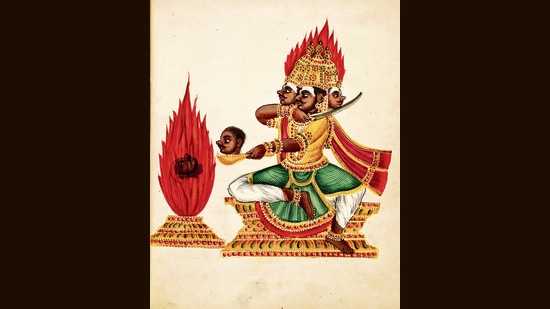Monsters have always been about fear and control. They are crafted to represent the deviant, alien or inexplicable as something to be wary of or shun. This is to prevent their illness or ill behaviour from infecting anyone else.
And so the myth of the werewolves is said to have its roots in cases of rabies; porphyria, which affects the formation of haemoglobin, has been linked to the myth of the vampire (patients tend to be pale, wan, and develop rashes and blisters when exposed to sunlight).
In the modern world, the terror extended to include the question: just what are we capable of? Mary Shelley’s Frankenstein (1818) is a man-made monster born of scientific overreach. In FW Murnau’s film Nosferatu (1922), the bloodthirsty monster is Count Orlok, his name the Dutch word for war. Robert Louis Stevenson’s The Strange Case of Dr Jekyll and Mr Hyde (1886) emerged amid the uproar caused by Charles Darwin’s theories of evolution (On the Origin of Species was published in 1859). If man emerged from ape, what else might lurk within us, beneath the veneer of civility and godlike self-image?
Go right to the beginning, and monsters represent the original unknowns: the mysteries of death and the afterlife; of mental illness; even the haunting spectres of one’s own misdeeds. As Wknd explore vampire myths, here are some of the oldest blood-sucking monsters from Indian lore.
Vetalas: Ghouls of the forest and cemetery
This wise but mischievous figure is said to hang upside-down from trees, in graveyards, crematoria and forests, and wait for humans to possess or play pranks on. In some tales, the vetala is wise and offers sage advice and visions of the future. In others, he is a dreaded being who takes delight in sucking human blood, killing children, causing miscarriages and driving people insane by filling their heads with his voice that never stops talking.
In both versions, a vetala or Betaal exists in the realm between life and death.
The earliest written tales about the vetala are the Vetala Panchavimshati, a collection of 25 Sanskrit stories compiled in the 11th century by the scholar Somadeva, drawing from ancient lore.
It is in these tales that a vetala comes to the aid of a king of legend named Vikram, a trope that would spark numerous tales for children told through centuries as the tales of Vikram and Betaal. In the original compilation, as in the later tales, the vetala is a hovering presence that taunts the king with riddles he can almost solve; he won’t leave the king alone, won’t go away, but eventually helps the king to greater victories and greater understanding.
Rakshasas: Insatiable troublemakers

As Brahma the creator slept, he continued to create, the myth goes. But he wasn’t crafting these creations; they were taking shape from his breath. When he awoke, he found that the beings were violent, aggressive. He called to Vishnu, the preserver: “Rakshama!” (Sanskrit for “Protect me!”) Vishnu banished these beings to the mortal world, and the first rakshasas were born.
They were a populous race in the worlds of the Ramayana and Mahabharata. They could be good or evil, and as warriors, they fought alongside human armies. Rakshasas were skilled magicians, illusionists and shapeshifters too.
In later lore, rakshasas grew even darker. They disrupted ritual sacrifices and other attempts by humans to reach out to and appease the gods. They desecrated graves, harassed priests, possessed humans. As the legends of their violence and ill will grew, they began to be depicted with bloodshot eyes, red hair and fangs, drinking blood from human skulls or cupped hands.
Peymakilir and Pey the merciful
What better place for bloodthirsty vampires than a battleground? The Pey and Peymakilir (male and female respectively) have their origins in Tamil lore. The Pey drains the blood of a soldier dying on a battleground, and is sometimes seen as a merciful being, because he hastens the soldier’s inevitable death. The Peymakilir is viewed as more vicious; she devours the flesh of the dead and the still-dying, dancing frantically as she rips at their flesh.
Chedipe: Sorceress of the night
The chedipe (literally, prostitute), a myth with origins in Telugu lore, is frequently depicted naked, riding a tiger through a forest at night. She is said to enter a sleeping man’s home and suck his blood through his big toe. The victim awakes in the morning feeling exhausted and slightly intoxicated, and if he and his family do not ward off the chedipe using holy icons and incense, she will return.
What makes her do these things? Legend has it that she represents the ghosts of devadasis, prostitutes, and women who died in childbirth or by suicide. She is said to live in the mangroves near the Godavari River (in present-day Andhra Pradesh), and attacks only men.
Pishacha: Devourer of body and mind
Pishachas are generally depicted with swollen red eyes and bulging veins. They are flesh-eating demons who haunt cremation grounds alongside other paranormal beings such as ghosts and vetalas. Pishachas are said to speak in a language of their own, have the ability to shapeshift and can render themselves invisible. They live off human energy, drawing on that energy by possessing humans and controlling their thoughts and actions. A human possessed by a pishacha develops a variety of ailments and may eventually descend into madness. They may also attack another human as a pishacha would.
Enjoy unlimited digital access with HT Premium
Subscribe Now to continue reading

Stay connected with us on social media platform for instant update click here to join our Twitter, & Facebook
We are now on Telegram. Click here to join our channel (@TechiUpdate) and stay updated with the latest Technology headlines.
For all the latest Art-Culture News Click Here
